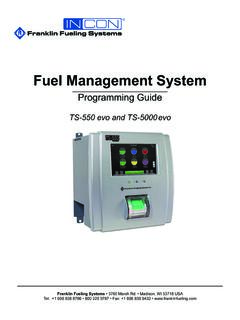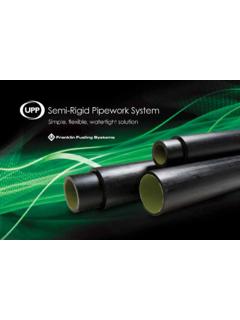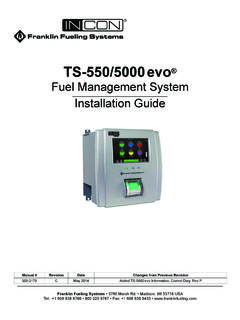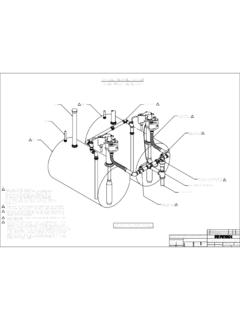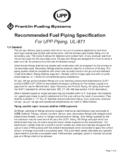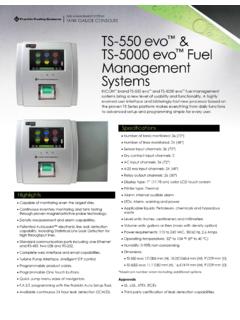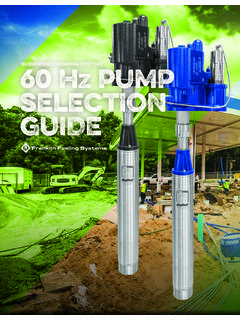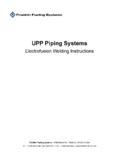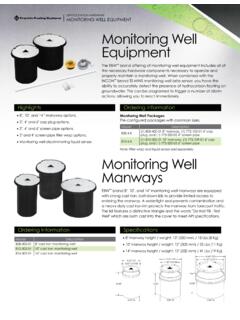Transcription of UPP Piping - Franklin Fueling Systems - Americas
1 UPP Piping Installation Guide Overview Franklin Fueling Systems 3760 Marsh Rd. Madison, WI 53718 USA. Tel: +1 608 838 8786 800 225 9787 Fax: +1 608 838 6433 Safety Important! UPP Systems must only be installed by fully trained and certified installers. Failure to follow installation instructions will invalidate warranty and installer certification! Piping Installation Safety Confined Space UPP Welding Units must never be operated in Zone Some installation of UPP products may occur 1 or Zone 0 areas (Hazardous area definitions are in confined spaces where a lack of oxygen and from IP Model Code of Safe Practice Part 15 and a concentration of toxic vapors is likely to be are available in the APEA Blue Book 2nd Edition). experienced. Ensure Welding Units are connected to a power Such working conditions are dangerous and all local supply that meets the requirements detailed in the health and safety guidelines for working in such user manual and are within the requirements of any environments should be followed.
2 Local authority or regional legislation. Material Handling Important to any type of Piping system is to safely Protective Equipment connect all metallic components to ground. Metallic Ensure the correct personal protective equipment components, and more general conductive materials, (PPE) is used at all times in line with local health due to their high capacitance, can have the potential and safety requirements. to store high amount of electrostatic energy (sparks Material Safety Data discharge can only be observed over conductive Ensure all safety data is accessed and used while elements). installing UPP Systems (Material Safety Data All exposed metal parts used in UPP System Sheets are available in the download area of the installations should be adequately grounded to a UPP website). dedicated earth electrode and brought to a potential Transport & Storage equal to that of other metal parts in the close UPP products should be transported and stored in proximity.
3 Accordance with the guidelines contained in this Chemical Safety manual. Where using chemicals (such as Acetone) during Heavy items the installation of UPP Systems products, be sure Heavy items should be handled using suitable lifting to follow all safety guidelines given on the chemical equipment operated by authorised personnel. containers themselves or on any accompanying literature. Contents Underground Fuel Pipe 3. Transit, On-loading and Uncoiling 4. Site Pipe Burial Pipe Bend 6. Completion 6. Pipe Detector 7. Pressure Testing Guidelines.. 7. UPP Recommended Pipe Test 8. Hydrostatic Pressure Testing 8. Sump Inspection 2. Introduction Underground Fuel Pipe Construction Underground Fuel Pipe Systems Black outer structural layer of the pipe is High Density Several types of underground fuel pipe are available for Polyethylene (HDPE), grade PE80 or PE100 which allows different applications and to meet various engineering and the use of electrofusion couplers and fittings to construct a legal requirements: variety of pipeline configurations.
4 HDPE PE80 and PE100. has well proven resistance to: stress cracking, puncture, U. PP Extra lined primary pipe with 100% nylon barrier scratch, impact, microbial and rodent attack. for product, suction, pressure, vapor vent and fill lines The intermediate layer is a tie-layer (adhesive) which U. PP Integral Secondary Containment pipe - for permanently bonds the polyethylene layer to the barrier layer. pressure Systems or environmentally sensitive sites. The yellow inner barrier layer of UPP Extra pipe is specially U. PP electrical conduit pipe- for underground electrical formulated fuel proof barrier layer which has exceptional wiring protection. resistance to absorption and permeation of both gasoline UPP Piping Systems are designed in various diameters, and alcohol fuel blends. from 32-160 mm (I -6 ) for the transfer of fuels in filling The smooth bore and low friction loss of UPP pipe permits station fore courts, marinas, and airports.
5 UPP Systems higher fuel and vapor flows when than steel pipe, reducing are also used for government and military installations as the pumping energy costs. well as many industrial sites such as mines and rail depots. UPP underground fuel pipe is pressure rated to 90 psi ( There is no requirement for a concrete trench because bar) according to UL971. Rupture pressure is typically fusion welded HDPE pipe is structurally resistant to weight exceeding 580 psi (40 bar) providing a large margin of of backfill material and dynamic traffic loads. Over 20 safety. years experience show no failures in underground fuel pipe Systems and no loss into the ground. Figure 1: UPP Pipe Structure Figure 2: Installation Overview 3. Transit, On-loading and Storage U. PP fittings - all electrofusion fittings are packed Although UPP polyethylene pipe and fittings are extremely in heat-sealed polyethylene bags and delivered hard wearing and resilient, it is important to handle and in cardboard cartons.
6 Fittings should be stored in store them with care to prevent scuffing or gouging. Any their packaging and in a dry area, away from direct damaged pipes may need to be rejected and not installed. sunlight, until ready for use. This is particularly important for electrofusion fittings. These must be kept UPP products should be transported in a flat-bedded in their packaging until ready for use to prevent any vehicle, free from sharp objects and projections. Wide contamination or oxidation. polypropylene slings must be used when lifting pipe crates by crane. Avoid using chains, hooks or hawsers. Uncoiling Pipe A spreading beam should be used when lifting crates containing pipe lengths greater than 19 ft 8" (6 m). Allow for a slight bending of the pipe crates when on and off-loading. S tandard 19 ft 8" (6 m) crates may be moved using a forklift.
7 A side loader fitted with a minimum of four supporting forks should be used for longer lengths. Otherwise use a crane fitted with a spreader beam. W hen using a forklift to on or off-load coils, the forks should be covered to avoid damage to the coiled pipe. Figure 4: Uncoiling Pipe The pipe can straighten with Caution considerable force. Take care when releasing pipe from the coil and secure the straightened pipe. Let the pipe rest in its uncoiled state for about eight hours. High ambient temperatures can reduce this layout time and low temperatures may increase it. Pipe can be laid in its final position to relax before connecting up. You need at least two people to uncoil and cut the pipe. The coil is taped up in layers to make it easier to uncoil at manageable intervals. Figure 3: Moving Coils The area in which the pipe is uncoiled on site must be Storage on site clear, safe and free of sharp objects.
8 I ndividual pipe lengths should be stacked not more than R emove the tape around the tail end on the outer 3 ft (1 m) high with the bottom layer fully restrained by winding and secure this end. wedges. The bottom layer of pipes should be laid on timber battens at 3 ft (1 m) centres to avoid any damage W ith the coil in the vertical position, roll the coil out from sharp objects lying on the ground. cutting and removing tape as you find it (ensuring to release only the next turn of pipe in the coil). P ipe crates should be stored on clear, level ground and should never be stacked more than three crates high. D o not drag the pipe. C oils should be stored on firm level ground that has The natural curves from coiling can be used to change suitable protection for the bottom of the coil. Stacked pipe direction and bags of sand, pea gravel or stakes coils should never exceed three coils high.
9 Individual can be used to hold it in place until it is ready for coils should be stacked flat. If stored on edge, they connecting. must be secured against a properly anchored support O ne person should hold the pipe whilst another cuts it and stored like this for a short period of time only, to the desired length. particularly in warm weather conditions. The cut ends will have a prominent hook that can be B adly stacked coils and pipe lengths can slip causing partially removed when weight is placed on it (bags personal injury or damage to the product. Facilities for of sand or pea gravel), or use the hook end to your safe lifting and moving must be available. advantage when turning direction into a chamber or P ipes are supplied with distinctive colored end caps to pump sump. prevent entry of any contamination. These end caps must be kept in place during storage.
10 4. Site Preparation Site inspection: Make sure the site is prepared and ready. The tanks and sumps should be in place IMPORTANT! The site should be free from previous fuel contamination. Figure 5: Pipe Spacing W hen laying duct onto a concrete base a 6" (150 mm). Pipe Burial Guidelines thick bed of compacted sand should be laid on the Recommended burial depth of UPP pipe is a minimum of concrete, below the duct. (The minimum amount of 12" (300 mm). sand should be 2" (50 mm) of compacted sand). All beds should be laid so that the pipe will not dip or All trenches should be sloped back towards the storage sag when it is installed. tanks. The fall back (slope) for all pipework to the tank chambers should be a minimum of 1/8" per foot or L aying of pipe should start from the tank farm 1 m every 100 m (Figure 7). This may vary to meet local U nderground pipe runs may be continuous or have requirements.
